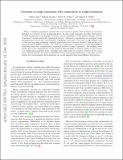Evolution in range expansions with competition at rough boundaries
Author(s)
Chu, Sherry; Kardar, Mehran; Nelson, David R; Beller, Daniel A
DownloadSubmitted version (2.193Mb)
Publisher with Creative Commons License
Publisher with Creative Commons License
Creative Commons Attribution
Terms of use
Metadata
Show full item recordAbstract
© 2019 Elsevier Ltd When a biological population expands into new territory, genetic drift develops an enormous influence on evolution at the propagating front. In such range expansion processes, fluctuations in allele frequencies occur through stochastic spatial wandering of both genetic lineages and the boundaries between genetically segregated sectors. Laboratory experiments on microbial range expansions have shown that this stochastic wandering, transverse to the front, is superdiffusive due to the front's growing roughness, implying much faster loss of genetic diversity than predicted by simple flat front diffusive models. We study the evolutionary consequences of this superdiffusive wandering using two complementary numerical models of range expansions: the stepping stone model, and a new interpretation of the model of directed paths in random media, in the context of a roughening population front. Through these approaches we compute statistics for the times since common ancestry for pairs of individuals with a given spatial separation at the front, and we explore how environmental heterogeneities can locally suppress these superdiffusive fluctuations.
Date issued
2019Department
Massachusetts Institute of Technology. Department of PhysicsJournal
Journal of Theoretical Biology
Publisher
Elsevier BV